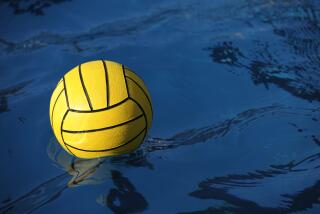Shoulder a Joking Matter?
- Share via
ATLANTA — U.S. water polo coach Rich Corso wanted to clear up the rumors about scoring star Chris Humbert’s aching left shoulder before tonight’s opening game against Italy, the defending Olympic and world champions.
“It’s a partial tear of the rotator cuff, but I did the surgery myself and took care of it,” Corso said.
For those who couldn’t see his straight face or hear his droll delivery, rest assured, he was making light of some of the doomsday stories about Humbert’s shoulder back home in Los Angeles.
It will become quickly evident if Humbert--who, as the squad’s best two-meter man and its scoring leader in every major international competition since 1991--is unable to carry the others on his sore shoulder. The match against Italy will set the early tone, helping determine whether the Americans are legitimate gold-medal contenders.
Humbert’s shoulder popped out of joint during training in Germany shortly before a final tuneup tournament at Rome in late June. He was sidelined for about two weeks, sitting out the four-match event, as did teammate Kyle Kopp, who had an inflamed left elbow.
A recent cortisone shot helped ease Humbert’s pain and he has been getting therapy three times a day at the Olympic village.
“It’s getting better,” he said. “The MRI that was done was negative, but there’s some disruption in there. There are good days and bad days.
“It will hurt. But who cares? It’s the Olympics.”
Even without Humbert and Kopp, the Americans nearly beat Italy last month. They lost, 8-6, but were tied in the fourth quarter, 6-6.
“I think we could have won that game,” utility man Rick McNair said. “It accomplished two things. It gave the rest of the team the confidence to know, ‘Hey, we can be without these two best players and we can play with these guys.’ The second effect it had, or it may have had, was it took some pressure off Chris and Kyle.”
In contrast, the Italians are under heavy pressure to repeat. Water polo ranks just behind soccer in popularity in Italy, and the success has come more often lately in the pool. The catalyst is the charismatic coach, Ratko Rudic, who won a silver medal playing for Yugoslavia in 1980 and then won gold as Yugoslavia’s coach in Los Angeles in 1984 and Seoul in 1988.
He took over the lagging Italian national team in 1990 and turned it into the Olympic champion in just under two years, the Italians winning at Barcelona in 1992. Italy also won the 1994 World Championships and the 1995 European Championships.
Rudic then retooled his team, casting off several veterans and bringing on eight new players, but Alessandro Bovo, Carlo Silipo and Amadeo Pomilio are still considered the emotional core of the team.
“The reason we changed is the evolution of the game,” Rudic said recently. “I want to follow the evolution. Speed is the future of this sport. The younger players can learn the new game better.”
Humbert, who played professionally in Italy, knows almost the entire squad and jokes about receiving Christmas cards from the team. He says that although the players may be different, Rudic’s system remains the same.
“They’re really smart players,” he said. “The biggest thing is to cut down on counterattacks, which they live and die by. They’re not going to take a lot of stupid shots from the outside.”
Corso remained unfazed about playing water polo’s version of the Dream Team. Here, in Atlanta, he discovered his wallet was missing and didn’t seem to care whether it was stolen, misplaced or lifted by his mischievous players.
“I labored on it for about 30 seconds, then I went back to breaking down films,” he said.
He canceled his credit cards, though, and wondered if his team was playing a prank on him and said he might have the final word.
“I’ve got their passports,” he said, laughing.
(BEGIN TEXT OF INFOBOX / INFOGRAPHIC)
Water Polo
The basics
Dates: July 20-24, 26-28.
Team has 13 players; six players plus a goalie are in pool at one time.
Players tread water the entire game.
All players, except goalie, must handle ball with only one hand.
Game has four seven-minute quarters. No timeouts.
A defender often fouls a player close to the goal to prevent him from scoring. The opponent is then awarded a free throw from the point where the foul occurred. Fouling is done mostly by impeding the free movement of an opponent who is not holding the ball.
A foul that is too aggressive by striking or pulling is penalized by a 20-second ejection. After three ejections a player is fouled out of the game.
Hole man: Similar to a center in basketball. The ball is fed into him, and he can try to score or pass to a teammate. The defender stops him from scoring by fouling him or stealing the ball.
The pool:
Depth: 1.5 - 2.0 m.
Goal: 3 m. wide and 1 m. high
More to Read
Go beyond the scoreboard
Get the latest on L.A.'s teams in the daily Sports Report newsletter.
You may occasionally receive promotional content from the Los Angeles Times.






